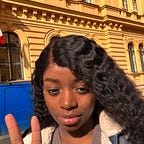Meet the Professor Behind the Viral Taylor Swift Course at Clive Davis
For you, I would cross the line… by sneaking into the class, and you can’t blame me either.
It’s not “folklore” that one of NYU’s Topics in Recorded Music classes was one of the talked about topics on the internet last week. The buzz around the new Taylor Swift-centered course at the Clive Davis Institute made headlines in Billboard, Variety, and even NPR.
Naturally, as with all Twitter discourse, the news of the class received mixed, yet undoubtedly enthusiastic responses. The grand majority wished they could be Clive Davis students and enroll in the course. “Looks like we’ll be moving to New York,” one user wrote. Another: “I’m ready to be a student again.” Their sentiments were echoed in dozens, if not hundreds, of tweets.
In an interview with NYU Local, professor Brittany Spanos detailed the inspiration behind the class and its curriculum and her experience so far juggling work as a first-time professor and full-time journalist.
Spanos, a senior writer at Rolling Stone, has an affinity for music and pop culture, especially Taylor Swift. “Taylor is someone that I’ve been a huge fan of since I was a teenager,” said Spanos. “And not only that, but she’s someone that I covered very often as a writer.”
Spanos has followed Swift closely since she started working at Rolling Stone in 2014, during the height of Swift’s 1989 popularity. Most of Spanos’ earliest articles covered Swift’s 1989 era, from her performance at Good Morning America in New York to the interactive app developed for Swift’s song, “Blank Space” — all while keeping up with Swift’s infamously turbulent love life. She even interviewed Swift for her podcast about Swift’s Red album.
Spanos’ knowledge and expertise on the 32-year-old singer-songwriter is one of the reasons that she suggested Swift as the focus of the course. Spanos said that she always wanted to teach a Topics in Recorded Music class since she was a student at NYU Gallatin (she graduated in 2014). However, it wasn’t until last summer that she finally took a leap of faith and emailed the Chair of the Clive Davis Institute, Jason King.
“I was like ,‘Well, it’s now or never to reach out and see if it’s a possibility that I could do this one day’ and so I sent him a few ideas,” said Spanos.
Her list of topic suggestions also included Britney Spears, Janet Jackson, and Tina Turner, but King ultimately decided to go with Swift. “Jason also just found [Swift] fascinating for this particular type of course because there is a lot to talk about in terms of who she is as an artist, her artistry in and of itself and from a music business standpoint,” said Spanos.
The course will cover topics such as Swift’s engagement with Black culture (including her “bad blood” with Kanye), and her portrayal in the media as a white country star. Spanos says students will also study her influence on younger teen songwriters, like Olivia Rodrigo and Billie Eilish, which Spanos describes as “immeasurable.”
The first class focused on Swift’s beginnings as a teen singer-songwriter in the Nashville music scene. “The class itself is going in pretty much chronological order of Taylor and her career,” said Spanos. “Every week sort of has a vague theme to it.”
Spanos also covered Swift’s rise as a pop artist during the era of Disney stars, like Miley Cyrus, the Jonas Brothers, and Selena Gomez. One class discussed how Disney’s purity culture and the “public’s fascination with her as a teenage songwriter” influenced Taylor’s public image. It ultimately impacted how she and others engage with her music and dating life, according to Spanos.
Swift’s fearless transition from country music to her resurrection as T-Swizzle in her Reputation album highlights her collaboration with Black culture as a white artist. T-Swizzle could rap and engaged with hip-hop/rap culture in a way that “You Belong With Me” Swift couldn’t.
“My own experience in classrooms teaching about white artists and white cultural figures is that race is often absent from those conversations,” said Spanos. “They only come up when you talk about black or brown artists or cultural figures.”
It’s fascinating and crucial to discuss Swift’s fandom and how Black fans were and are affected by her actions and words about racial issues like Black Lives Matter, added Spanos.
The endgame for the course is for Spanos’ students (many of whom grew up as Taylor Swift fans, she noted) to learn how to “re-engage with [Swift] from a perspective beyond just love.” She continued, “I want them to be able to come in and re-learn how to listen from a critical standpoint.”
Spanos added that for her students who are less familiar with the class’ namesake, she hopes that they “learn how to appreciate that type of songwriting and listen to her and understand her beyond the way that the public has shaped her.”
“I want them to have fun listening to music and engage with pop music beyond the idea of pop as guilty pleasure,” said Spanos.
Spanos said that her experience teaching so far has been a rollercoaster, in no small part due to the social media attention that this class is getting.
“The attention part has been very overwhelming, so I don’t know how I feel about that part yet,” she laughs. “I hope the mass attention to the class has not been crazy and disruptive for them [her students], but it’s definitely been wild.”
Spanos hopes to teach another course in the future, either covering Swift again or another artist. “I love music. I love music history. And I’m really enjoying this new endeavor,” she said.
